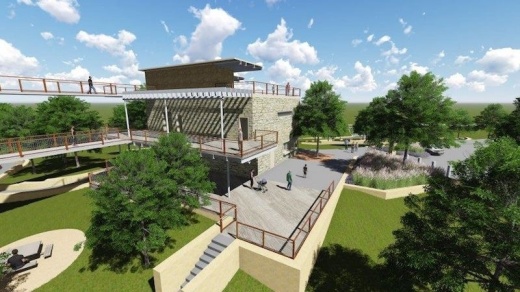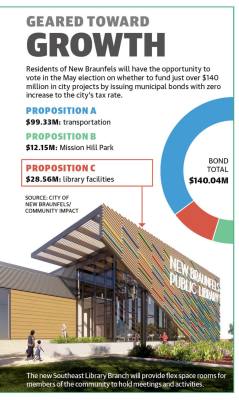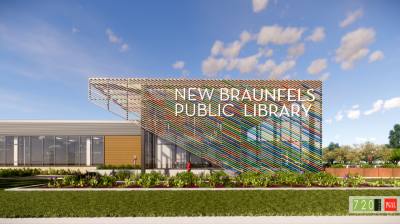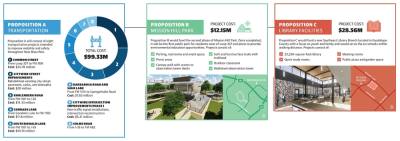The bond will have no impact on the tax rate, and voters will determine if they would like to approve the three separate propositions on the May ballot. New Braunfels Mayor Rusty Brockman said it was important to the City Council to not raise taxes to pay for the bond due to the economic state of the county.
“Everyone is struggling a bit,” Brockman said. “Everyone’s dealing with inflation; everyone’s dealing with higher prices on everything. And to be able to ask the community to support these projects, which are really very important to the success of us continuing to grow in a healthy and safe way, I think people understand how important that is at this time.”
To determine the projects that will be considered for funding, the city went through a lengthy process that began with compiling a list of potential projects in May 2021. The city Bond Advisory Committee was made up of members of the community who met over the course of several months and received presentations from city staff members on potential projects.
Pastor Ray Still, chairperson of the committee, has served in the same capacity for both the 2013 and 2019 bonds. He said community involvement is important to the process.
“To me, the recommendation that we’re going to be voting on that City Council and the bond committee presented is really reflective of what the citizens themselves said they needed in the community,” Still said.
The committee was able to narrow down over $800 million in potential projects to $180 million, which was recommended to the City Council. Council then reviewed the recommended projects and looked at possible funding scenarios, including collaborating with the New Braunfels Economic Development Council to decrease the amount and allow there to be no impact on the local tax rate.
“[The NBEDC] wants to invest in key projects, and they found alignment with the proposed bond slate,” said Jonathan Packer, CEO of the Greater New Braunfels Chamber of Commerce. “And while I can’t speak for the board members individually, I know that they’ve provided direction to the city staff to bring them opportunities in the coming months to invest in bond projects so that citizen dollars can go further.”
Money toward mobility
If passed, Proposition A will allocate nearly $100 million toward eight transportation projects throughout the city. Taking up 71% of the May bond, the projects on the list were determined based on feedback from the community and by analyzing areas of projected growth.
“[New Braunfels is] one of the highest-growing cities for the last decade every year. So [we are] trying to keep up with that growth and address the demands of growth on our transportation network,” said Garry Ford, New Braunfels transportation and capital improvements director.
In 2022, the city of New Braunfels conducted the National Community Survey to provide an accurate picture of the livability and resident perspective of local government services. The survey results showed the lowest scores came from residents’ satisfaction with transportation and mobility throughout the city.
Survey respondents rated the overall quality of the city’s transportation structure at 30% with 78% of those polled saying the city should focus on improving transportation infrastructure in the next two years.
“One thing that rises to the top whenever you survey the business community or residents in general is the need for investment in transportation,” Packer said.
The largest project, totaling nearly $25 million, included in Proposition A is widening Common Street to a four-lane road with turn lanes and making intersection improvements to Loop 337, Gruene Road, Old FM 306 and FM 306. Other projects include widening Barbarosa Road/Saur Lane and Kohlenberg Road from two lanes to four lanes and improving the existing two-lane road on Conrads Lane with turn lanes at major intersections.
Citywide intersection improvements will also be included in the proposition with new traffic signals to be installed at San Antonio Street and Market Drive, Walnut Avenue and Gardenia Drive, and multiple locations along Loop 337 and Hwy. 46.
“Every time we meet as a council with the public being present, they talk about how crowded the roads are and how important new roads and new pathways to get across town and how important good roads and good highways are to our community,” Brockman said.
Street improvements throughout the city would also be funded with $20 million allocated to rehabilitating existing curbs and sidewalks, improvements to pavement markings and sidewalks, and rehabilitation determined by the city’s Pavement Management Program. The city anticipates being able to make improvements to around 19 miles of existing city streets with the funding, according to Ford.
“We’re addressing mobility and congestion, but we’re also evaluating pedestrian and bicycle mobility with each one of these projects,” Ford said. “There are components and elements of these projects that would either have a shared-use path, a pedestrian or enhanced pedestrian crossing at an intersection. So again, we want to make sure that we’re addressing the multiple modes of transportation on our transportation network with vehicles, but also pedestrian and bicycle traffic.”
Paying for parks
Voters will also see Proposition B on the May ballot, which would allocate over $12 million to completing the second phase of Mission Hill Park. The 10-acre park will be located on Independence Drive off Hwy. 46 in New Braunfels.
“The community has worked hard to get the initial trail and some parking there now, and let’s go ahead and finish this out so that it can be a type of show place the entire community can enjoy,” Brockman said.
The bond funding would go toward the construction of a multilevel observation tower with a canopy walk that allows for access to observation tower decks. Improvements would be made to parking and restrooms, and an event space would be constructed.
“Because the EDC is going to be so gracious with their funding for several parks projects, it gave [City Council] the opportunity to be able to complete a project that has gotten started with the roadway up to it,” Brockman said.
Both soft and hard surface trails with trailheads would also be constructed. Mission Hill Park would be the first public park for residents west of Loop 337, providing historic and environmental education opportunities. The park got its name from a Spanish mission in the area from the mid-1700s and is the highest point in New Braunfels, according to the Sophienburg Museum and Archives.
“I think the meaningful part [of Mission Hill] park is the history and how impactful that has been on the community of New Braunfels for almost the entire history of the town,” Brockman said.
Expanding library accessibility
A new 23,000-square-foot Southeast Library Branch will be constructed in New Braunfels on the corner of South Walnut Avenue and Settlers Crossing if voters pass Proposition C on the May ballot. The $28 million new library facility would provide library services to a growing part of the city.
“I’ve watched the community grow, and I have seen the impact that the library can make in the community,” New Braunfels Library Director Gretchen Pruett said. “And one of our biggest challenges in the town is managing the growth and trying to provide the same level of services to every single person in the city, and with the library what we found is that as the city grows and traffic becomes worse, not everybody is able to get to the library when they need it.”
According to Pruett, the national standard cities try to meet to ensure the library size meets the needs of the community is to allocate 0.6 square feet of library space to each resident. By combining the square footage of the main library branch with the Westside and Southeast branches, the city will have 68,000 square feet of library space throughout the city, which is just enough to keep up with the growing community.
“Right now, every book that comes in, one has to leave,” Pruett said. “We don’t have the capacity to have more books, and while the Westside Branch will help, it’s not enough additional shelving to really change that, and [library staff] don’t like that.”
The Southeast Library Branch will have a youth and family focus to serve the six schools that are within walking distance. The facility will feature quiet study rooms, technology spaces, meeting rooms, and a public plaza and garden space.
The new branch would also be dedicated to providing quality after-school programs with four individual spaces for child care activities included in the design. According to the Library Master Plan, the construction timeline for the Southeast Branch would be 24 months once the project breaks ground.
“We know that library services are important for families, and so we were seeing the part of town that had the most families and was the fastest growing; it was the southeast quadrant of New Braunfels,” Pruett said.








